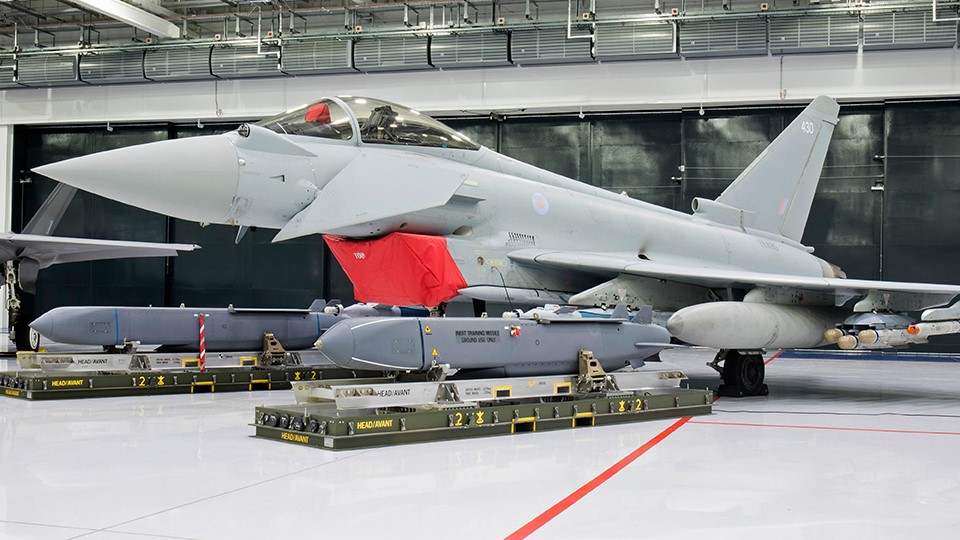
The Storm Shadow has been the UK’s main air-launched cruise missile for decades. (UK MoD)
LONDON — Even as it continues development on a future high-end cruise missile, the UK Ministry of Defence is pursuing the design of a more affordable precision munition for the F-35B and ”generation-after-next” platforms including UAVs, with a top official revealing details for the first time this month.
The Defence Science Technology Laboratory (Dstl) has launched a study on the future viability of a Medium Range Utility Strike Weapon (MRUSW) supported by an industrial consortium featuring MBDA, Thales and Raytheon, with the goal of investigating the art of the possible for MRUSW with particular focus on affordability and minimal integration onboard air frames, according to Dstl officials. The effort, known formally as the “WSRF 0058 Utility Air Strike Weapon Concept Study,” is scheduled to report its findings in Q3/Q4 2023.
Addressing delegates Nov. 17 at the Royal Aeronautical Society’s ”Weapons for the Generation After Next Platform” conference in London, Dstl’s Jonathan Burnage described the MRUSW as an additional capability to SPEAR (Selected Precision Effects at Range) Capability 5 — a long-range replacement for the in-service, low-observable air-launched Storm Shadow cruise missile.
According to Burnage, ongoing development of SPEAR Cap 5 is focused on “stand-off, navigation and payload size.” In comparison, MRUSW is expected to be more interested in cost, combat mass and, to a lesser extent, navigation.
“MRUSW is a capacity gap rather than a capability gap,” Burnage urged before suggesting the munition will be a “cheap, high combat mass weapon” to complement, rather than replace, SPEAR Cap 5. “This would enable the UK to attack a wide range of fixed targets with [a] limited number of aircraft,” he said before suggesting MRUSW could also be considered a “substitute” weapon in “less demanding situations.”
RELATED: UK, French officials gather to decide future of missile technologies
The ability to fly with as many MRUSWs as possible was highlighted by Burnage as “imperative” in the concept study. He suggested the Royal Air Force’s (RAF’s) F-35B could carry as many as eight MRUSWs, split equally between its pair of weapon bays.
The study will consider powered and unpowered concepts in addition to penetrator warhead design, along with ability for high accuracy in Attack on Coordinates mode as well as navigating in the presence of GNSS jamming, Burnage said.
According to Burnage, the first priority for MRUSW must be the prosecution of “moderately hardened structures and small, medium size soft buildings.” The second priority, he said, should be ability to engage static, mobile and relocatable targets — of particular interest following Russia’s Feb. 24 invasion of Ukraine and the popular employment of mobile missile launchers and artillery pieces that has been seen since. Additional requirements call for the munition to be guided onto a target by on- and off-board laser target designators.
Burnage also described a pair of use cases for MRUSW including pre-planned, stand-off and simultaneous launch of eight munitions to destroy the same number of small bunkers in a GNSS-denied environment, as well as deployment of a single munition to engage a moving target at shorter range, enabled by laser target designation.
The potential design process of MRUSW could also include a variety of next-generation technologies. Burnage specifically highlighted next-generation navigation technologies such as inertial measurement units; resonant acoustic mixing (RAM) techniques for warheads; and additive manufacturing processes. He also suggested the MRUSW development might not necessarily feature seeker technology.
The working group will also look at flexible stockpile management and improved integration and qualification processes.
It’s clear the MoD is looking at other systems as it works on this design phase. In his comments, Burnage referenced the Nov. 9 American deployment of palletized Joint-Air-to-Surface Standoff Missiles from an MC-130J Commando II at the Andoya Space Range, Norway — but questioned whether the RAF’s A400M could support a similar capability with Storm Shadow cruise missiles. Such a concept, he said, would provide “a lot of combat mass” but at great expense.
Speaking to Breaking Defense at the conference, Burnage suggested MRUSW could enter service within the next decade, should the concept study conclude the development is a worthwhile venture. The biggest challenge facing the MRUSW might not be a technical one, however.
There is no guarantee it will become an official program, especially with looming questions about London’s defense spending. On Nov. 17, the UK government delayed approving an expected rise in defense spending to 3 percent GDP by 2030. In his Autumn Statement speech, Chancellor of the Exchequer Jeremy Hunt could only confirm the country’s defense budget would remain “at least two per cent of GDP to be consistent with our NATO commitment.”
More details are expected to be announced in the MoD’s Integrated Review Refresh, scheduled to publish by the end of the year.
Also speaking at the conference, Group Captain Nick Lowe, Deputy Head of Weapons, Evaluation and Capability Assurance in the RAF, suggested generation-after-next weapon systems could come sooner than expected.
“I’m not sure how far the generation after next really is? Some things can endure but we need to get there quickly. We need to be able to generate winning capability and more quickly. How much more quickly depends on others and being able to deliver at pace of relevance. That’s the challenge. So how do we get after the solution,” he asked
In a ‘world first,’ DARPA project demonstrates AI dogfighting in real jet
“The potential for machine learning in aviation, whether military or civil, is enormous,” said Air Force Col. James Valpiani. “And these fundamental questions of how do we do it, how do we do it safely, how do we train them, are the questions that we are trying to get after.”


























